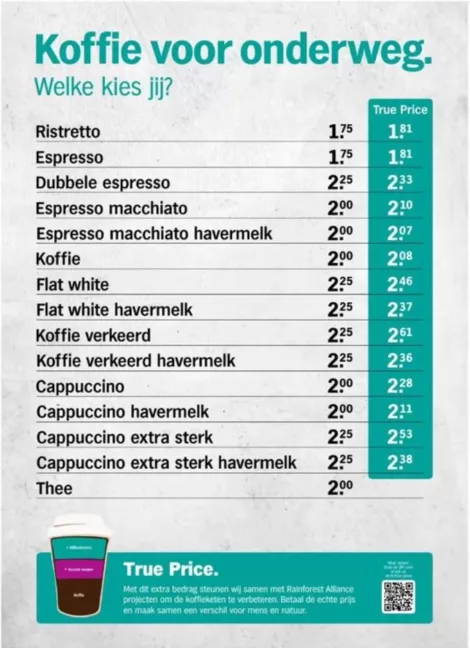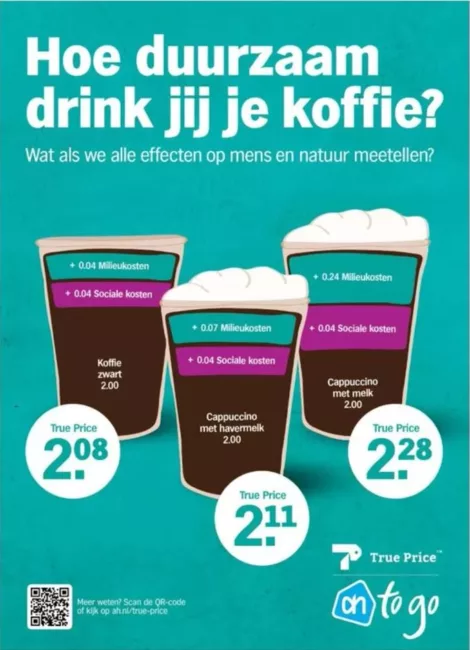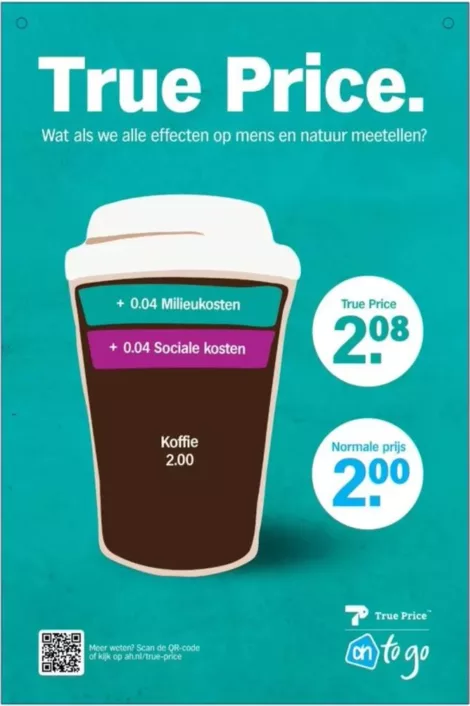Finding the right pricing is a tricky business. Even more so when price becomes a vector for behavior change, in other words, a “nudge.” Dutch retailer Albert Heijn is currently experimenting with a rather original form of pricing that highlights the “real price” of each product consumed. The aim is to make consumers aware of the impact of their consumption. This approach is one of the pricing techniques that influence behavior.
Need help with your pricing? Contact the IntoTheMinds Research Agency

Albert Heijn displays the true price of its coffee
For the past few weeks, AH (Albert Heijn) stores in Zaandam, Groningen, and Wageningen have displayed the “real price” of their takeaway coffee. By “true price,” we mean the price that considers “negative externalities.” The aim is to make consumers aware of the impact of their consumption on the environment and those who produce the raw materials.
Albert Heijn’s customers have a choice: pay the normal price or the true price. This is a nudge marketing technique.
True prices are generally 3% to 16% more expensive than the normal price. This is due to the ingredients used. Let’s take an example. A ristretto costs €1.75, but the real price is €1.81. The difference of 6 cents corresponds to the environmental
- the environmental costs of producing and transporting coffee
- social: insufficient remuneration of coffee producers in poorer countries
In the case of cappuccino, the difference rises to 14%. The reason lies in cow’s milk. Its production has a major impact on the environment. You’ll notice that substituting oat milk for cow’s milk considerably lowers the “real price.” The difference falls from 14% to 5.5%.
Calculating the “True Price”
Behind Albert Heijn’s operation lies the Amsterdam-based organization True Price. Founded in 2012, it aims to encourage retailers to display the true price of their products.
The calculation is based on a methodology that considers negative externalities, i.e., costs linked to the extraction of raw materials, the manufacture of products, and their transport;… These costs can be both environmental and social. The method goes even further since negative externalities, such as the impact of corruption, are also considered.
This enables True Price to calculate a “true price,” which is, of course, higher than consumers in developed countries pay. In addition to Albert Heijn’s coffee, True Price’s website gives examples of other products whose impact is particularly high. In the textile industry, for example, a pair of jeans’ environmental and social costs are assessed at around €30. In other words, when you buy a pair of jeans, you pay €30 less than they cost, considering their manufacture’s social and environmental impact.
Publicity stunt or a real nudge?
Albert Heijn’s initiative must, of course, be analyzed in the light of communication objectives. Today, companies – particularly large ones – must be irreproachable regarding CSR (Corporate Social Responsibility). Albert Heijn, part of the Ahold Delhaize retail group, would like to obtain B-Corp certification.
This initiative is primarily a communications operation. It will undoubtedly raise customer awareness. However, knowing Dutch consumers, I think they will unlikely pay the “real price.” Much more radical action is needed to change behavior. A nudge isn’t just about providing information, however interesting it may be. The consumer must be dissuaded from taking a potentially negative action or pushed more firmly in the right direction. It would have been more effective to create a real price differential to the advantage of oat-based beverages rather than keeping them at the same price as those made with cow’s milk.
Posted in Marketing.

